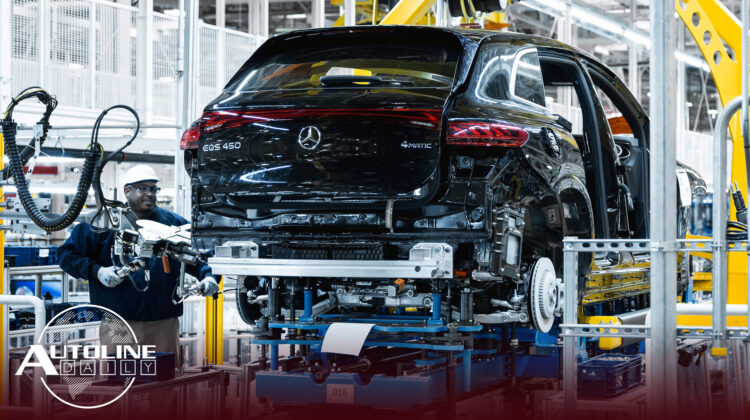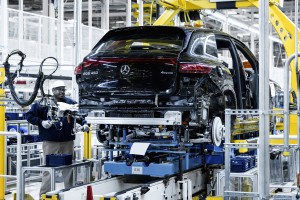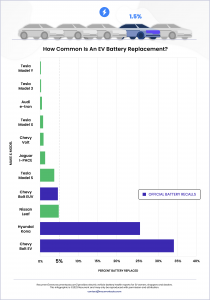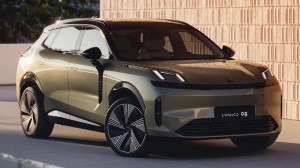
Listen to “AD #3653 – UAW Cripples Mercedes-Benz Production; Could UAW Target Tesla?; EV Sales Up 102% in Europe” on Spreaker.
Follow us on social media:
Runtime: 10:28
0:00 UAW Cripples Mercedes-Benz Production in the U.S.
1:20 More Plants Could Strike by Noon Tomorrow
1:47 A Flaw in the UAW’s Strike Strategy?
3:29 EV Batteries Can Last the Life of a Car
4:31 NIO 1st Car Maker with Its Own Smartphone
5:15 EV Sales Up 102% in Europe
5:54 Marelli Closes ICE Plant Due to EV Growth
6:15 Geely Helps Launch China’s 1st Auto-Grade 7NM Chip
7:01 Continental & Ethernovia Developing 7NM Chip
7:35 Mercedes Turns to Tech to Improve Manufacturing
Visit our sponsors to thank them for their support of Autoline Daily: Bridgestone, Intrepid Control Systems, Schaeffler and Teijin.
This is Autoline Daily, the show dedicated to enthusiasts of the global automotive industry.
UAW CRIPPLES MERCEDES-BENZ PRODUCTION IN US
We’re now a week into the UAW strike and union president Shawn Fain figured out a way to indirectly cripple Mercedes-Benz’s production in the U.S. The UAW went on strike against a ZF plant that makes axles for the Mercedes plant in Alabama which makes the GLE coupe and a couple of SUVs including the $171,000 Maybach GLS. Without any axles it will bring the Mercedes plant to a screeching halt. The ZF plant, who’s workers are organized by the UAW, are asking for the same things as workers at the Detroit Three. And this could signal a new front in the labor war, where the UAW figures out ways to shut down the transplants. After all, the Detroit automakers are worried that their new labor contract will put them at a severe labor cost disadvantage to the transplants and Tesla. But if the union can pressure the transplants to unionize then GM, Ford and Stellantis will not be at a disadvantage. And here’s something to keep a lookout for. Can the UAW figure out a way to shut down Tesla?
MORE PLANTS COULD STRIKE BY NOON TOMORROW
Shawn Fain says if there isn’t significant progress in negotiations he’s going to start shutting down other plants at GM, Ford and Stellantis at noon tomorrow. So yesterday Stellantis gave the union its 5th proposal. No details were announced, but our sense of the situation is that Fain feels he can still get more and we expect he’ll follow through on his threat to expand the strike.
A FLAW IN THE UAW’S STRIKE STRATEGY?
But here’s something that maybe the union didn’t consider in its strike strategy. So far Fain has only gone on strike against three plants, one at each of the Detroit Three. That helps the union preserve its strike fund, which had $825 million before the strike started. But GM, Ford and Stellantis are laying off workers at plants that can’t get or supply parts to the plants that are on strike. So far, they’ve laid off 2,970 workers. Fain may not have seen that coming. And since the union promised to pay any laid off workers $500 a week, that means the union is burning through $1.48 million a week more than it probably planned for. And if Fain does expand the strike tomorrow, we can expect many more UAW workers who are not on strike to get laid off anyway.
WARGAMING THE LABOR WAR
By the way we’re going to get into far more detail of what this strike means and how it’s likely to end up on Autoline After Hours later this afternoon. Laurie Harbour from Harbour Results, Kalea Hall from the Detroit News and Sam Fiorani from Autoforecast Solutions will be on the show. So if you want to learn how this labor war is really being fought, join us when the show goes live at 3 pm eastern time.
EV BATTERIES CAN LAST THE LIFE OF A CAR
How long will the batteries last? That’s one of the first questions you hear from people who are skeptical about EVs. Well, how does this sound to you? They’ll probably last longer than the life of the car. A new study from battery analysis company Recurrent found that only 1.5% of EVs have had to have their batteries replaced. It looked at real world data from 15,000 EVs in the U.S. from different automakers and found that batteries likely will last longer than the vehicle. The data showed that most EVs with around 100,000 miles on them still have at least 90% of their original range left. But the researchers point out that the data is constantly evolving because most EVs aren’t that old, 30% of them are only a year old and the majority of the rest are less than six years old. And if one does go bad, batteries can be costly to replace, anywhere from $5,000 to $22,000 depending on the model.
NIO IS 1ST OEM WITH ITS OWN SMARTPHONE
A bunch of different tech companies are dipping their toes into the auto industry, so it seems only fitting that auto dips its toes in the tech industry. Chinese automaker NIO is launching its own smartphone, which is an Android-based device that appears to offer similar specs to other top phones. It’s roughly the same size as the new iPhone 15 and pricing starts right around $900. There’s extra benefits for NIO EV owners, like seamless integration with their infotainment screen and the ability to control vehicle functions, like the door locks. NIO’s not the only Chinese automaker getting into smartphones. Geely also has a device on the way.
EV SALES UP 102% IN EUROPE
EV sales in Europe are really starting to take off. According to the European Automobile Manufacturers Association, EV registrations soared 102% in August to nearly 197,000 units. And they hit 20% market share for the first time. The overall car market in Europe is going strong. Registrations were up 21% to more than 900,000 vehicles, the 13th straight month car sales have increased in Europe. And while that’s great news, overall sales are still down a quarter from pre-pandemic levels.
MARELLI CLOSES ICE PLANT
That sales surge of EVs in Europe is starting to impact the ICE side of the business. The supplier Marelli announced that it’s closing a plant in Italy that produces parts for internal combustion engines because the business is “unsustainable” due to the ongoing drop in ICE sales.
GEELY DEVELOPS ITS OWN 7NM CHIP
The US banned sales of high tech chips to China, so China is developing some on its own. Chinese automaker Lynk&Co, which is part of Geely, is kicking off sales of the 08 SUV, a plug-in hybrid that features China’s first domestically developed automotive-grade 7-nanometer chip. The 08 actually has two of these chips, which reportedly have the same computing power as Qualcomm’s SnapDragon chips, the same chips that several legacy automakers will use for their future Software Defined Vehicles. The 08 SUV is priced between $28,000 and $39,000 and got 10,000 orders in the first 10 days it went on sale.
CONTINENTAL & ETHERNOVIA DEVELOP 7 NM CHIP
Speaking of automotive-grade 7-nanometer chips, the German supplier Continental is going to make them with a Silicon-valley startup, called Ethernovia. These chips will be used in Software Defined Vehicles and will allow faster data transfer, connectivity solutions and ADAS, including autonomy. The two did not reveal when they will start offering the chips. But Ethernovia does have two other investors we find interesting and those are Porsche and the previously mentioned Qualcomm.
MERCEDES TURNS TO TECH TO IMPROVE MANUFACTURING
While the Mercedes plant in Alabama may be shutting down because of the UAW strike, it’s using innovative technology to improve its manufacturing at other plants. It’s completely digitizing its plants in Germany, Hungary and China to more efficiently prepare for its all-new EV platform, called Mercedes Modular Architecture or MMA for short. The Concept CLA Class that was shown at the IAA auto show in Munich is the first vehicle revealed that rides on an early version of this platform. But by creating a digital twin of its manufacturing sites, Mercedes is already able to map out where all the machines will go that will build those cars, even though they won’t go into production until sometime around 2025. So, once it does go to put in the actual machines it takes half the time it normally would. It also allows Mercedes to get its suppliers more involved earlier in the process, which cuts down on even more time. Another interesting implementation of tech, is the use of AI in the painting process. By allowing AI to control the booth where cars are painted and get their top coat it slashed energy use by 20%. So, now it’s looking at other areas where it thinks AI might be able to help.
But that brings us to the end of today’s show. Thanks for making Autoline a part of your day.
Thanks to our partner for embedding Autoline Daily on its website: WardsAuto.com
Seamus and Sean McElroy cover the latest news in the automotive industry for Autoline Daily.










